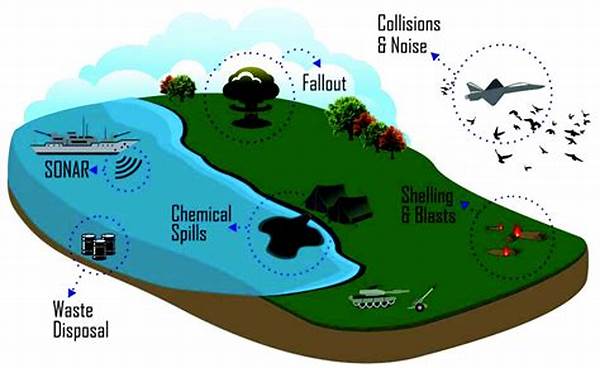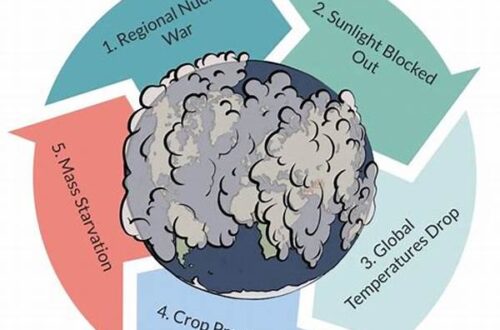Understanding the Environmental Impact of Military Operations
In contemporary discussions regarding environmental preservation, the impact of military activities is a subject of profound concern. Military operations, often perceived as essential for national security, unfortunately, have significant environmental repercussions. The pollution repercussions from military activities are multifaceted, encompassing land, air, and water pollution that persist long after the cessation of military operations. One of the primary sources of such pollution is the release of harmful chemicals during training exercises and the deployment of military hardware. The use of explosives, heavy machinery, and toxic agents contributes substantially to environmental degradation. Moreover, military bases, often expansive in nature, are known to produce substantial waste that can contaminate surrounding ecosystems. These installations frequently utilize vast quantities of fossil fuels, contributing to significant air pollution and greenhouse gas emissions.
The pollution repercussions from military activities extend beyond immediate geographical locales, infiltrating ecosystems and affecting biodiversity. The movement of military vehicles can lead to soil erosion, while chemical spills and discarded ordnance contaminate water sources, posing risks to aquatic life and human populations relying on these resources. Additionally, the long-term consequences of such activities often manifest in the form of ecological imbalances and habitat destruction, leading to the displacement of wildlife. Therefore, while military activities are crucial for maintaining national security, it is imperative to acknowledge and mitigate their environmental impacts through sustainable practices and stringent regulatory frameworks. The integration of environmental considerations into military planning and operations remains critical for reducing pollution repercussions and preserving ecological integrity in the face of inevitable security demands.
Specific Sources of Pollution from Military Activities
1. Chemical Contaminants: Military operations frequently involve the use of hazardous chemicals, introducing serious pollution repercussions from military activities into the environment. These chemicals can seep into soil and groundwater, leading to long-term environmental and health challenges.
2. Explosive Residues: The detonation of explosives during military operations leaves residues that contribute to pollution repercussions from military activities. These residues can persist in the environment, affecting ecosystems and contributing to soil and water contamination.
3. Fossil Fuel Consumption: High fossil fuel usage in military vehicles and aircraft results in considerable air pollution and greenhouse gas emissions. The pollution repercussions from military activities due to fossil fuel reliance are evident in increased atmospheric concentrations of pollutants.
4. Abandoned Ordnance: Unexploded ordnance left behind from military exercises poses significant pollution repercussions from military activities. These remnants can lead to chemical leaching and pose hazards to both human and animal populations.
5. Waste Generation: Military bases generate substantial waste, which can result in serious pollution repercussions from military activities if not managed properly. This waste, ranging from discarded equipment to hazardous materials, can pollute local environments.
Efforts to Mitigate Environmental Impacts
To address the pollution repercussions from military activities, various mitigation strategies are being developed and implemented. One notable approach involves the adoption of environmentally friendly technologies and practices within the defense sector. This includes the integration of renewable energy sources such as solar and wind power, which serve to reduce the dependency on fossil fuels and minimize air pollution. Furthermore, the military is increasingly focused on enhancing waste management practices to ensure that hazardous materials are appropriately disposed of, diminishing the possibility of environmental contamination.
Another strategy is conducting environmental impact assessments before, during, and after military operations. These assessments facilitate the identification of potential environmental risks and aid in formulating effective response strategies to mitigate pollution repercussions from military activities. Additionally, investment in research and development of cleaner technologies, such as the development of biodegradable materials for military use, can significantly decrease the environmental footprint of defense activities. Collaboration between the military and environmental organizations can also foster the exchange of knowledge and best practices, enabling a comprehensive approach to addressing the ecological challenges posed by military operations.
Legislative and Policy Frameworks
1. Environmental Regulations: Establishing robust environmental regulations is crucial in minimizing pollution repercussions from military activities. Implementing comprehensive policies can help ensure that military practices align with environmental conservation goals.
2. International Agreements: Participation in international environmental agreements encourages nations to commit to reducing pollution repercussions from military activities. Such agreements facilitate cooperation and accountability in environmental preservation efforts.
3. Monitoring and Reporting: Implementing systems for monitoring and reporting pollution repercussions from military activities ensures transparency and accountability. Regular assessment of environmental impact aids in identifying areas of concern and adapting strategies accordingly.
4. Sustainable Practices: Adoption of sustainable practices in military operations contributes to reducing pollution repercussions. This includes resource-efficient technologies, minimal-waste policies, and ecological restoration projects.
5. Training and Education: Providing environmental training and education for military personnel fosters awareness of pollution repercussions from military activities and instills a sense of responsibility toward ecological preservation.
6. Research and Development: Investing in research and development for green military technologies promotes innovation aimed at alleviating the pollution repercussions from military activities. Emerging technologies can provide cleaner alternatives for defense operations.
7. Interagency Collaboration: Encouraging collaboration between military, governmental, and environmental agencies enhances the implementation of effective strategies to address pollution repercussions from military activities.
8. Community Engagement: Involving local communities in decision-making processes regarding military activities ensures that pollution repercussions are managed with consideration for local ecological and human health.
9. Adaptive Management: Employing adaptive management techniques allows military organizations to adjust practices in response to observed pollution repercussions, facilitating a dynamic approach to environmental stewardship.
10. Continuous Improvement: Committing to continuous improvement of environmental practices ensures that efforts to minimize pollution repercussions from military activities evolve with advancing knowledge and available technologies.
Technological Innovations for Environmental Protection
Recent years have seen a surge in technological innovations aimed at mitigating pollution repercussions from military activities. These innovations range from the development of eco-friendly materials to the deployment of advanced monitoring systems that track and analyze environmental impact in real time. For instance, the adoption of biodegradable packaging materials for military supplies significantly reduces waste and pollution. Additionally, cutting-edge emission control technologies for military vehicles and aircraft have been designed to curb greenhouse gas emissions, thus addressing air pollution issues associated with military operations.
The integration of unmanned aerial vehicles (UAVs) equipped with environmental sensors marks another advancement in monitoring pollution repercussions from military activities. These UAVs can perform environmental assessments over vast areas, providing invaluable data on pollution levels and enabling swift responses to environmental threats. Furthermore, the military is exploring the potential of artificial intelligence and machine learning algorithms to optimize resource usage and mitigate environmental impact. Such technological innovations not only highlight the military’s commitment to environmental stewardship but also present opportunities for collaboration between defense agencies and civilian environmental entities to enhance overall ecological outcomes.
Community and Environmental Partnerships
Engaging with local communities and environmental organizations is imperative for mitigating pollution repercussions from military activities. Establishing partnerships with stakeholders fosters a collaborative approach to addressing environmental concerns, ensuring that military operations are conducted with due regard for ecological and human welfare. Through such partnerships, the military can gain insights into local environmental dynamics and tailor strategies to minimize pollution repercussions effectively. Furthermore, community involvement in environmental decision-making processes empowers locals to voice concerns and contribute to sustainable solutions, enhancing transparency and trust between military entities and civilian populations.
Environmental organizations play a crucial role in advocating for accountability and best practices in military operations. By working hand-in-hand with these organizations, the military can leverage expert knowledge and resources to further its sustainability objectives. Collaborative efforts may include joint conservation projects, educational initiatives, and the development of shared frameworks for environmental monitoring and management. By prioritizing community and environmental partnerships, the military can demonstrate its commitment to reducing pollution repercussions and promote a culture of environmental responsibility in defense operations.
Summary of Pollution Repercussions from Military Activities
In summary, the pollution repercussions from military activities are a significant concern within the broader context of environmental conservation. Military operations, by their very nature, possess inherent environmental risks, contributing to land, air, and water pollution that can have enduring ecological and health impacts. The sources of such pollution include the use of hazardous chemicals, the reliance on fossil fuels, and the generation of substantial waste from military bases. These activities not only affect local ecosystems but can also have far-reaching consequences, disrupting biodiversity and contributing to global environmental challenges.
Addressing the pollution repercussions from military activities necessitates a multifaceted approach encompassing technological innovation, stringent legislative frameworks, and collaborative efforts between military and civilian sectors. Implementation of sustainable practices and technologies, along with comprehensive monitoring and reporting systems, can significantly mitigate the environmental impact of military activities. Moreover, involving local communities and environmental organizations in these efforts ensures that military operations are conducted with due regard for ecological integrity. Ultimately, a concerted commitment to environmental stewardship within the defense sector is crucial for balancing national security needs with the imperative of preserving planetary health for future generations.





